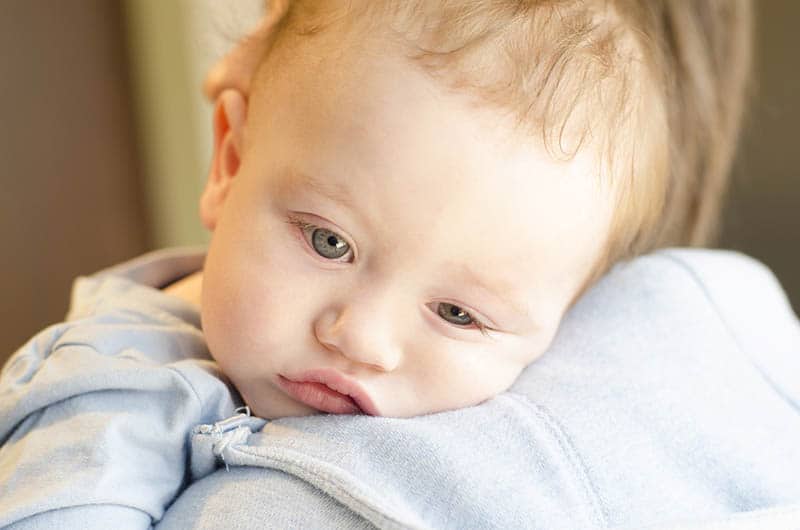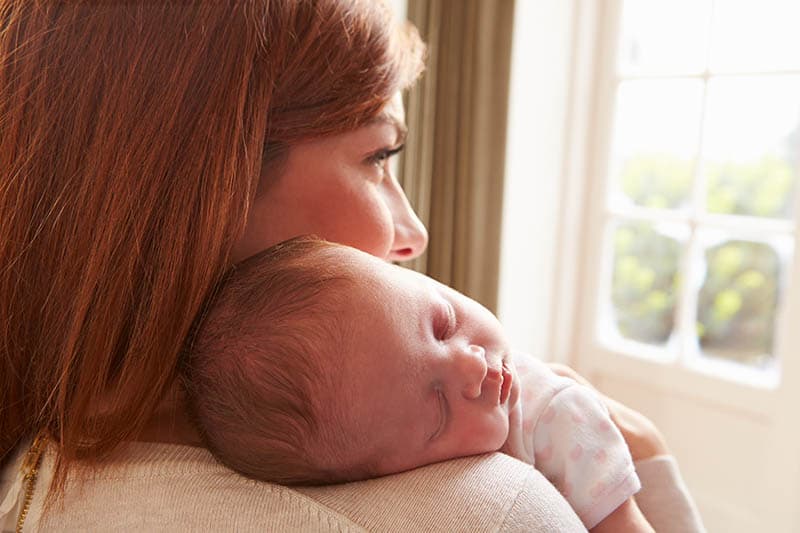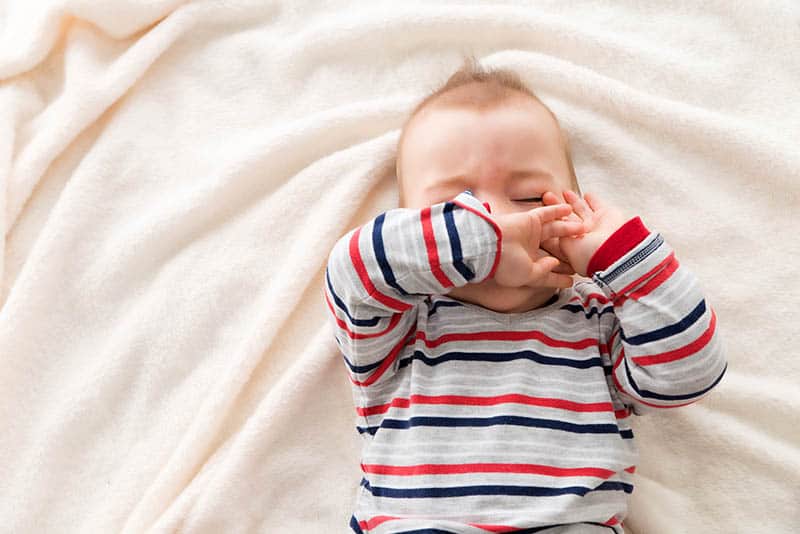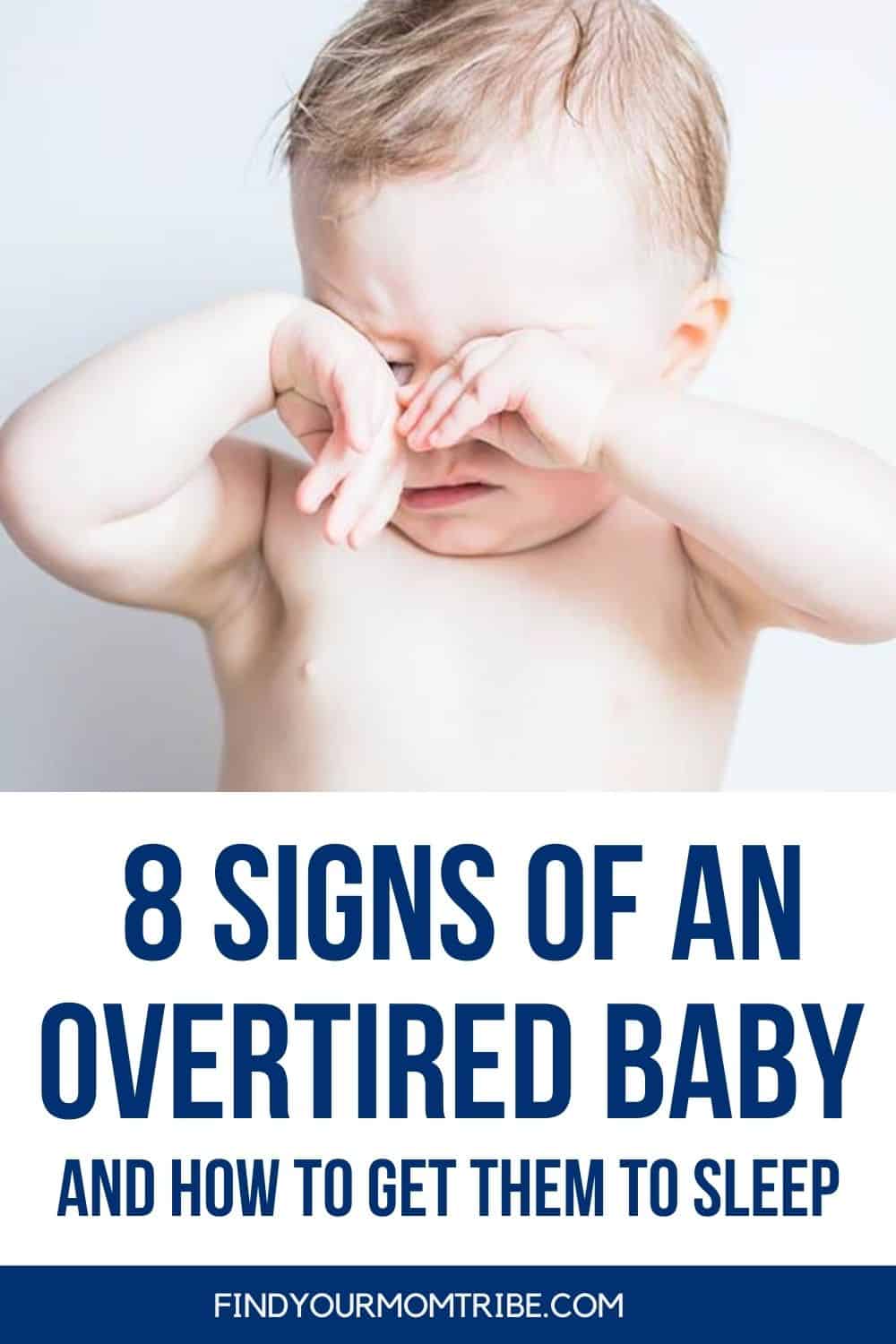Every mom knows that putting a baby to sleep isn’t always the breeze it’s imagined to be, so having an overtired baby on your hands can turn bedtime or naptime into an especially difficult undertaking.
Sometimes getting your little one to sleep turns into a tricky task even when every possible condition is right.
Naturally, that means that an overtired baby is particularly tricky to deal with. Nervousness, clinginess, and crying are just some of the things your baby probably does while fighting sleep.
In short, overtired babies tend to have a problem with falling asleep and suffer from disrupted sleep throughout the night, which in turn leads to more nervousness and thus a vicious cycle is formed.
Of course, this leaves us with a tired little baby who will continue to be tired until the cycle is broken, and that’s just heartbreaking to watch. Every baby deserves her much needed sleep.
So, what are the best things to do when your little one has a hard time falling asleep?
Put everything you were doing aside and pay full attention to your baby. The trick is to relax the baby.
One of the most efficient things you can do is swaddle the baby or hold her tight against your chest (even if she fights it). The second most efficient way is breastfeeding your baby or giving her a bottle or a pacifier.
Make sure that the environment you’re in won’t distract her from falling asleep.
That means that the lights should be dimmed, there should be no loud noises, and the temperature needs to be optimal.
Ideally, you should play white noise or create it by using household items such as a hairdryer or vacuum cleaner (personally, that was my saving grace).
To understand why some things work and others don’t and to learn more about how to encourage your overtired baby to get enough hours of sleep I made a quick informative list.
What are the signs of an overtired baby?

Signs of overtiredness are signs it’s already too late. However, they must be recognized so we can act accordingly and give the right support and care to the baby.
Babies who stay awake for too long end up suffering from a stress response.
A stress response is basically an increase in stress hormones (adrenaline and cortisol), which is exactly why it’s so hard to put babies to sleep once they’re tired.
Cortisol and melatonin change throughout the day and affect a baby’s sleeping habits.
What you need is melatonin (the hormone of sleep) to override stress hormones and allow your baby to sleep peacefully.
Most of the time it’s very clear that your baby is overtired. However, other times the signs are not so easy to spot. Here’s what to look for in your little one:
1. Rubbing eyes, ear, or head
This is the number one giveaway sign that a baby’s time to sleep has already passed.
It looks adorable but in reality, it’s a big warning sign. If she’s rubbing her eyes, ears, or head – it almost certainly means she’s VERY tired.
Try to react immediately and start with the sleep routine.
2. Clinginess
This is another big giveaway of tiredness.
Clinginess is the ultimate way for a baby to tell you I need your attention. She literally wants your dedication to help her ease her tiredness.
Clinginess is seen in the way a baby cries and insists on physical touch.
As a matter of fact, there’s a special way of crying that’s used for this kind of situation, and it’s the same when it comes to a hunger cry, pain cry, etc.
3. Zoning out
Zoning out and losing concentration is a very common result of overtiredness.
A baby’s brain (and the human brain in general) isn’t able to engage in things around them as well as when they’re fully rested after a good night of sleep.
4. Less engagement
Naturally, with tiredness comes weaker performance on multiple levels, including the body.
Your baby already lost most of her energy during her awake time and now she’s running low on energy but unfortunately can sleep.
You’ll notice she doesn’t react normally to the things she usually finds useful and interesting.

5. Taking brief naps
Naptime outside of scheduled nap time is definitely a sign of an overtired baby.
Unpredictable short naps out of nowhere say that your baby is indeed tired and needs sleep to get her energy back.
Short naps will only mess with schedule later on, so it’s best to avoid them if possible and stick to the usual routine.
6. Fussiness
Now, fussiness may appear for different reasons.
It doesn’t have to be down to tiredness, it could be some other type of issue such us: diaper rash, sensitivity to food, stomach cramps, or feeling too hot.
Nevertheless, if your baby is irritated and tired from lack of sleep, she’s going to be very fussy and you’ll certainly notice.
7. Meltdown and tantrums
This one applies to older babies and older children who can express themselves in this way.
A tired baby is susceptible to expressing their emotions in rather interesting and usually loud and attention grabbing ways.
Meltdowns and tantrums are not always caused by sleep deprivation but it’s one of the causes.
The state of sleep deprivation creates a sense of uneasiness and tension and makes emotions swirl. That often results in emotional outbursts.
When it comes to this, please don’t panic but know that it will pass.
Don’t punish your child for having a tantrum but understand that the feelings they are feeling are new to him or her and they need to express themselves in the only way they know.
Sometimes that way is not convenient when we look at the situation from a grown up point of view but it’s reasonable when it’s seen from the perspective of a child.
Don’t feel awkward when it happens in a public place. This happens to all parents everywhere, and there’s no point in judging something that’s a natural and normal behavior for a child of that age.
8. Randomly falling asleep
If you find your baby falling asleep in random places while doing random activities (for example, falling asleep in the high chair or immediately after being put into the stroller), it’s obvious that the baby needs more sleep.
How to get an overtired baby to sleep?

1. Keep swaddling your baby
Why does swaddling almost always work?
Swaddling is a way to help the baby adapt to the external world once they’ve left the safest place on earth, their mother’s womb.
It’s not easy to change one’s environment completely and not get nervous when things suddenly get very different, right?
We don’t give babies enough credit. Leaving the womb to live in this busy world is kind of stressful after all.
Swaddling keeps babies’ arms and legs in place, which is important because the startle reflex can cause a baby to wake up.
Other than that it keeps a baby cozy, warm, and feeling safe – everything you need for a nice, restful sleep.
2. Minimize eye contact
Why is making eye contact while putting your baby to sleep a bad idea?
Now, I know that looking at your baby’s eyes is a sweet habit and a natural thing to do.
However, when it comes to putting the baby to sleep – you should avoid it. For a baby, making eye contact means engagement. It wakes her up and energizes her.
In other words, baby translates your eye contact as a sign for playtime, and that’s the last thing you want. You don’t want to pull her out of her sleeping zone.
3. Play white noise
Don’t underestimate the power of white noise. Almost all sleep tips for babies include white noise.
Newborn babies love it and there’s a good and scientific explanation behind it.
White noise reminds babies of the noises they heard while growing inside your womb. Isn’t that amazing?
White noise neutralizes sounds from the environment just like the sound of a beating heart and rushing blood masked the outside noises in the womb.
In other words, you want to recreate the feeling of being in the womb as closely as possible, because that’s exactly the thing that’s going to make your baby feel safe and calm.
4. Try different ways of holding your baby
Usually, most babies like to be held tightly against the chest. It makes them feel secure.
Feeling a slight weight and pressure is also known to help with calming before sleep (think for example about weight blankets).
But, what if that doesn’t work for your baby?
Try different ways of holding her – for example, lean her on your shoulder and let her look around over it or try the so-called football hold.
5. Find the right movement
Back when my baby was a newborn, trying to find the rhythm and movement to get my baby to sleep definitely made me look funny at times, to say the least.
Of course, I didn’t care because nobody’s got time for that when you have a crying baby on your hands.
At some point, I even think it turned into a mild workout routine that consisted of squats and lounges, but hey, anything for the baby, right?
I remember sitting on the pilates ball and tirelessly bouncing for hours because that was the only way my baby would fall asleep.
Looking back at it now, I see it was better than the equally awkward phase that required deep lunges while tightly holding the baby and which always ended up with soreness.

6. Learn baby’s sleepiness cues
All babies have their similarities but they’re all different. That means that the way they display their sleepiness is different.
Some of the cues include yawning, less activity, zoning off, getting quieter and calmer, having no interest in play, redness around the eyes, no focus, and fussiness.
You need to learn to recognize these signs in your baby. Does she become less focused and quiet? Does she get redness around the eyes?
It’s possible to notice all these things and start with a sleeping routine on time, just try to pay attention and take notes.
Later use that observation to start naptime after you notice the fist cues, stick to that routine for a while, and see what happens.
Don’t forget that the signs that show a baby’s sleepiness change over time and as she gets older. The sleep cues of a baby are different from the sleep cues of a toddler.
7. Go through your standard sleep routine if it’s possible
Don’t give up on your standard routine – but if it doesn’t work – ditch it and try something else.
Don’t insist on fulfilling every step that usually works, because the baby is probably too tired for that at this point.
However, a scheduled sleep routine is usually what makes scenarios like this never happen. It’s the key to a night of good sleep.
Make the bedtime routine predictable and maintain it.
Newborn sleep habits change a lot in the first period of their life and they’re very different from toddler sleep habits so make sure you stay on track.
Sleep routines usually include a bath, a diaper change, changing into PJs, a little snuggling, bedtime stories, and whatever else you love doing with your precious baby.
Keep all activities calm, slow, and quiet so the baby doesn’t get too excited.
8. Create a calming environment for your baby
What does a calming environment consist of?
We already mentioned that dimmed lights and white noise can make all the difference. Of course, this also calls for regulated temperature and making sure your baby is not too hot or too cold.
The amount of light is important because light creates a distraction for the baby and any distraction can trigger more fussiness.
Make sure that people around you know you’re putting the baby to sleep and therefore make as little noise as possible.
And last but not the least, don’t forget to make yourself comfortable too. Mums need their comfort because putting an overtired baby to sleep is hard work.
9. Experiment and see what works
Try all of the things above and see what works for you and your baby.
Keep trying other things too, track what your baby likes and finds calming or interesting, and keep her occupied with that while making sure it includes repetitive and slow patterns.
Anything can work, it all depends on your baby and you.
You might find that sometimes seemingly silly things work the best – and when I say silly I mean awkward movements and unexplainable routines you don’t know how you came up with.
Try to cuddle or sing lullabies, try those funny moments I was talking about, try different sources of white noises… and above all be patient, and don’t give up easily. Sleep problems are not only baby’s but yours too.
10. Don’t do it all by yourself
Don’t overwhelm yourself or the baby. It’s better to keep yourself calm and collected, especially if the baby is nervous or crying.
Don’t try too many things at once because it’s better to concentrate on one thing and do it right than do many things with not enough effort.
If you feel too tired and nervous – ask for help! A fresh and calm person to help can make a big difference even if it’s just for a short period of time.
Now that you have some solid advice on how to make your overtired baby fall asleep, let’s concentrate on preventing it from ever happening again.
Let’s learn the signs and see how we can use sleepiness cues to make sure your baby doesn’t get overtired again.
Why do babies get overtired easily?

Babies are new to this life.
Everything that happens is a completely new experience to them. They’re basically adjusting to a new environment which is full of different input and simulation.
That’s why they can get overwhelmed and fatigued easily.
They’re processing too much information at once. I bet you would feel tired too!
The other important thing connected to sleep is the fact that growth hormone is secreted more rapidly when the baby’s asleep – which means they really need a good sleep and explains why babies grow so fast, especially in the first five months!
All in all, it’s perfectly normal for a baby to feel tired and get tired easily because of how much is going on in their little baby minds.
What to do to prevent overtiredness?

The biggest tip when it comes to preventing overtiredness and ensuring your baby wakes and falls asleep on schedule is developing a consistent routine. Baby’s love routine.
However, the first six months are hard for maintaining routine because the baby is trying to adapt and find a sleeping rhythm that suits her.
After about six months you should actively try to implement some sort of routine.
By that time, you’ll notice that the baby has naturally formed a sleeping pattern – and that’s what you should use as a guide for making a routine.
What does a regular sleep routine look like?

First of all, let me just say that the duration of the sleep routine has a lot to do with the temperament of your baby, the activities you did that day, etc.
It can last as little as 15 minutes or as long as one hour.
If the baby had an active day and a lot of new things happened, the routine will naturally last a bit longer.
If you and your baby spent most of the day cuddling in bed, then routine will probably be a lot shorter.
No matter the duration, there are a few things you should never skip.
An average sleep routine timeline should look something like this:
Step one: change the diaper, apply lotions and give a baby a bath.
Step two: massage your baby after a bath, put her in PJs, make the room dark, turn on white noise, and swaddle.
Step three: feeding the baby, cuddling, and engaging in calming activities.
Step four: make sure baby burps after feeding, make sure there’s no hiccups or any other physical discomforts, then move to the bedroom, hold and rock your baby to fall asleep.
Step five: at this point, a baby should be drowsy, gently put her in the crib.
Step six: here comes the tricky part. Leaving the room can be triggering so make sure you do it quietly and try using a swaddle beforehand to give your baby a feeling of comfort and of being embraced.
If step six doesn’t work, here are a few sleep training methods you can try to get your baby to sleep on her own.
What is sleep training and is it effective?

Sleep training is the process in which you teach your little one to fall asleep by themselves and it typically involves certain methods and techniques that help that happen.
Essentially, it’s helping the baby develop her own sleep pattern by herself.
Sleep training is effective and it’s especially recommended for new parents to try out. It goes without saying that sleep training requires discipline and consistency from the parents.
There are a few efficient and popular sleep training methods I want to share with you, so let’s start.
1. Ferber method
This method is also called the check and console method and it goes like this: After putting the baby down you want to check on her periodically but without rocking or feeding her to sleep, because the point is to make her fall asleep on her own.
After finishing the bedtime routine and putting your baby down to sleep, exit the bedroom and wait for a certain amount of time to pass, usually a few minutes.
After that, enter the room and interact with the baby by saying something like don’t worry, mommy’s here or something similar, or give her a gentle pat or a touch.
Ideally, you shouldn’t pick the baby up.
This method, however, is applicable to babies over 7 months of age because babies below that age need to feel the frequent closeness of the parent so they don’t feel abandoned.
This method consists of checking the baby for whatever period of time you choose (make it under 15 minutes) until she finally falls asleep.
If everything goes smoothly, it usually starts to work after about a week. Of course, it’s not guaranteed that every single method will work for every child, but that’s why there are few of them.
2. Chair method
This method requires disciplined parents.
The idea is that after putting the child to sleep one of the parents sits next to the crib.
After the baby falls asleep, the parent can leave the bedroom and every time the baby wakes up they return to the chair until the baby falls asleep again.
The trick is to move the chair further each night until you’re completely out of the room.
What’s great about this method is it doesn’t require leaving the baby alone while falling asleep and it doesn’t require only one parent. Both parents can try this method.
However, there’s still a possibility that the baby will cry, and picking her up will ruin the whole method. Naturally, the baby may act differently every night, so it’s pretty hard to stay consistent and disciplined.
Critics of this method highlight the fact that having the uninvolved parent in the room while the baby is crying might badly influence and confuse the baby.
3. Put down and shush-pat method
This method consists of putting the baby down to sleep and standing over the crib, shushing and patting them while they’re falling asleep.
It also allows you to pick up the baby if she’s acting very nervous, hold her until she starts to fall asleep, and then put her back in the crib.
This method works best for small babies under the age of 7 months. Older babies are too stimulated by interaction and return to wakefulness.
4. Cry it out
The cry it out (CIO) or extinction method is definitely the most controversial method of all on this list. It essentially involves not responding to crying after putting the baby in the crib.
Of course, this doesn’t include completely ignoring the baby, but only reacting for example after one or two wakeups. It also includes normal feeding if the baby needs one during the night.
Many parents are worried about the crying and how long and intense it might be.
According to those who recommend this method, the first few nights of crying are hard to listen to, but eventually, the baby stops crying and starts having peaceful and independent nights of sleep and forming a healthy sleep schedule.
5. Bedtime-routine fading
This routine has a simple concept in theory.
It involves continuing your previous sleeping methods, such as swaddling, nursing, etc, and simply decreasing the amount of time you spend doing them until the baby falls asleep.
As expected, this doesn’t always translate into reality as it should, but it’s worth trying.
6. Bedtime-hour fading
The bedtime-hour fading routine involves gradually moving bedtime to an earlier time. Basically, you put the baby asleep at one time for a few nights and then start putting her to sleep an hour earlier.
Don’t stress!

Things are going to improve!
Your now overtired baby is waking every hour but will soon hop onto that sleep schedule and then you’ll see the real progress and benefits.
Your baby will be in a good mood again and you will finally get some rest. Just have a little patience!
This state of tiredness is only a transient state that you’ll soon forget.
If you have any concerns that your baby’s tiredness is caused by any other reason of a medical nature, ask for advice from a pediatrician or any other doctor that might help you.
Remember that you’re doing everything you can and that everything will be okay. Don’t be hard on yourself.
Another thing you should remember is that you can’t instinctively know all of your baby’s preferences and needs because they literally just entered this world – you just met each other.
Getting to know your baby takes time and that’s perfectly normal. Don’t feel guilty for not understanding everything right away – it’s simply not possible.
Don’t forget to be consistent, to be patient, and to take care of yourself too. Your little one needs you as fresh and lively as you can possibly be.
I hope that these sleep tips will help you encourage your precious baby into a carefree and restful sleep and allow you to rest and prepare yourself for another adventure with your little one.
Like this post? Please share or pin it for later. You can also stay in the loop and follow us on Facebook, Instagram and Pinterest.

This post contains affiliate links. Please see our full disclosure or more info.

